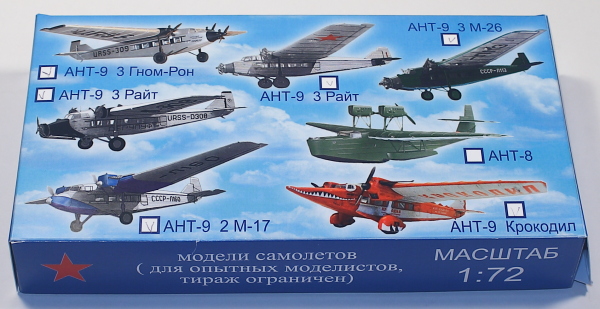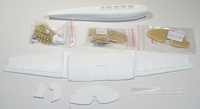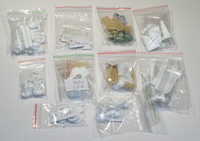
Airkits 1/72 Tupolev ANT-9
By Matt Bittner
Introduction
The Tupolev ANT-9 was a Russian domestic airliner developed during the 1920s and flew in production during the 1930s. It carried nine passengers and was used in a variety of areas and roles. There were also different types built, based on engines and other factors. One of the most recognizable of the derivatives is the one known as "Krokodil" (Crocodile) based on how the machine was constructed and painted.
The Kit
 I usually provide a parts count when I first talk about a model that was sent for review. This time I won't, because Airkits was kind enough to send all parts for every single variant that can be built with their standard 1/72 ANT-9 kit. The different versions that can be built include the 3M-26, the ANT-9 with 3 Wright engines, "Krokodil" and 2M-17. This sample Airkits sent includes the separate parts for each version in a separate baggie for each varaint. That's why I'm not counting, nor showing, all variant's parts. I do not want to mix up any of the parts and make the build difficult.
I usually provide a parts count when I first talk about a model that was sent for review. This time I won't, because Airkits was kind enough to send all parts for every single variant that can be built with their standard 1/72 ANT-9 kit. The different versions that can be built include the 3M-26, the ANT-9 with 3 Wright engines, "Krokodil" and 2M-17. This sample Airkits sent includes the separate parts for each version in a separate baggie for each varaint. That's why I'm not counting, nor showing, all variant's parts. I do not want to mix up any of the parts and make the build difficult.
Airkits was also quite kind in supplying decals for all versions as well, and these decals appear to be in register and are nicely printed.
 When you purchase this kit for yourself, you'll have to make the decision right up front on which version you want to build. Me, I'll have to think about it a lot to decide which version I'll build. It will either be "Krokodil" or one of the "3 Wright engines" (there are decals for three different aircraft of that version).
When you purchase this kit for yourself, you'll have to make the decision right up front on which version you want to build. Me, I'll have to think about it a lot to decide which version I'll build. It will either be "Krokodil" or one of the "3 Wright engines" (there are decals for three different aircraft of that version).
Once you have the kit in hand, then construction won't be very difficult. The kit comes with a full interior, not only in the cockpit, but also throughout the rest of the cabin. You'll glue all the separate seats to the floorboard, then glue that into the main cabin. The cockpit consists of a rear bulkhead, rudder pedals, control columns, and the pilot's and co-pilot's seats. Once all interior parts are painted and in, then you'll glue the top of the fuselage to the one-piece bottom, completing the majority of the fuselage.
 The wing consists of three parts, and you'll have some clean-up to perform prior to gluing these parts together. Once all parts are together and dried then it is added to the fuselage. After that is all dried you'll add the forward fuselage to the model, dependent on the variant being modeled. In addition, you'll add the vertical and horizontal tail pieces. The last construction steps is adding the nose (be it the long nose for the "Krokodil", the blunt nose for the two-engined version, or an engine if building a tri-motor variant) the wing engines and the landing gear.
The wing consists of three parts, and you'll have some clean-up to perform prior to gluing these parts together. Once all parts are together and dried then it is added to the fuselage. After that is all dried you'll add the forward fuselage to the model, dependent on the variant being modeled. In addition, you'll add the vertical and horizontal tail pieces. The last construction steps is adding the nose (be it the long nose for the "Krokodil", the blunt nose for the two-engined version, or an engine if building a tri-motor variant) the wing engines and the landing gear.
One area I commend Airkits on is the inclusion of pieces of metal rod inside the landing gear struts when the resin was poured. Because this is a big model and all resin, it will be heavy so having metal rods inside of the landing gear will give the necessary strength.
Conclusion
The most difficult part of this model will be deciding what version you want to build. All of them are interesting and colorful - more so the "Krokodil" - so once you've finally figured which one to build, then purchase it and start building. I'm really looking forward to starting the Airkits 1/72 ANT-9 as I think it will look great on the shelf sitting next to almost anything.
Huge, huge thanks to Airkits for sending this kit to review. If interested in purchasing the ANT-9, or any other of their excellent kits, then send an email to the owner.
